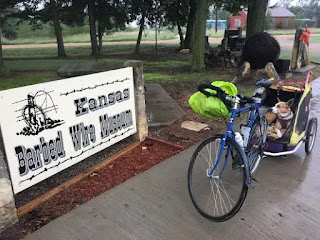Minnesota State College Southeast, in the city of Red Wing, has a guitar repair and building program. That program has a waiting list.
So, why am I mentioning it in this blog?
Well, folks at the college realized that the reason why so many students signed up for the program is something every educator knows: Students will be engaged, work hard and learn well when teachers encourage students to work on something that fits their passions.
That is a scenario Travis Thul, the college's Dean of Trade and Technology, wanted to replicate in another program he's helping to create. He says the college was looking for something that has "unique, tangible emotional appeal" while, at the same time, "encompassing the core competencies of mass manufacturing."
So what did he and the college come upon? Well, since you're reading this blog, you may have already guessed the answer: the bicycle. As he says, most people have grown up with a bicycle and recall the fun they had with it. Also, the city of Red Wing has a "bicycle-oriented culture," with trails that attract riders from the surrounding areas.
Furthermore, Minnesota and neighboring Wisconsin have companies that represent a disproportionate amount of the US bicycle business, so there are job opportunities for graduates of the college's bicycle design and fabrication program. The first classes--which include algebra and physics--will be held in the Fall of 2019, and the first graduates are expected to get their Associate of Applied Science degree in 2021 after completing 60 credits.
While students will study traditional aspects of bicycle design, Thul says that he and other faculty members decided, "it's very important that core mathematics and physics are taken seriously" because "the force distribution on one bicycle frame is going to be different from the force distribution on another frame." Also, he hopes that this background will help and encourage students to take on another passion of his: designing and building adaptable bicycles for handicapped people.
But the most important goal of the program, according to Thul, might be to help students develop transferable skills. "A drivetrain is a drivetrain. Gearing is gearing. Welding is welding," he explained. They are skills, he says, that can be "used at Red Wing Shoes, Fastenal, Valley Craft" and many other local--and worldwide--manufacturing companies.
The program certainly sounds interesting,and I can't blame Thul for thinking he has the right idea. After all, he recently received a call from the CEO of a company in Montreal, Quebec. That CEO wants to hire graduates of his program.
So, why am I mentioning it in this blog?
Well, folks at the college realized that the reason why so many students signed up for the program is something every educator knows: Students will be engaged, work hard and learn well when teachers encourage students to work on something that fits their passions.
That is a scenario Travis Thul, the college's Dean of Trade and Technology, wanted to replicate in another program he's helping to create. He says the college was looking for something that has "unique, tangible emotional appeal" while, at the same time, "encompassing the core competencies of mass manufacturing."
So what did he and the college come upon? Well, since you're reading this blog, you may have already guessed the answer: the bicycle. As he says, most people have grown up with a bicycle and recall the fun they had with it. Also, the city of Red Wing has a "bicycle-oriented culture," with trails that attract riders from the surrounding areas.
Furthermore, Minnesota and neighboring Wisconsin have companies that represent a disproportionate amount of the US bicycle business, so there are job opportunities for graduates of the college's bicycle design and fabrication program. The first classes--which include algebra and physics--will be held in the Fall of 2019, and the first graduates are expected to get their Associate of Applied Science degree in 2021 after completing 60 credits.
While students will study traditional aspects of bicycle design, Thul says that he and other faculty members decided, "it's very important that core mathematics and physics are taken seriously" because "the force distribution on one bicycle frame is going to be different from the force distribution on another frame." Also, he hopes that this background will help and encourage students to take on another passion of his: designing and building adaptable bicycles for handicapped people.
But the most important goal of the program, according to Thul, might be to help students develop transferable skills. "A drivetrain is a drivetrain. Gearing is gearing. Welding is welding," he explained. They are skills, he says, that can be "used at Red Wing Shoes, Fastenal, Valley Craft" and many other local--and worldwide--manufacturing companies.
The program certainly sounds interesting,and I can't blame Thul for thinking he has the right idea. After all, he recently received a call from the CEO of a company in Montreal, Quebec. That CEO wants to hire graduates of his program.

















